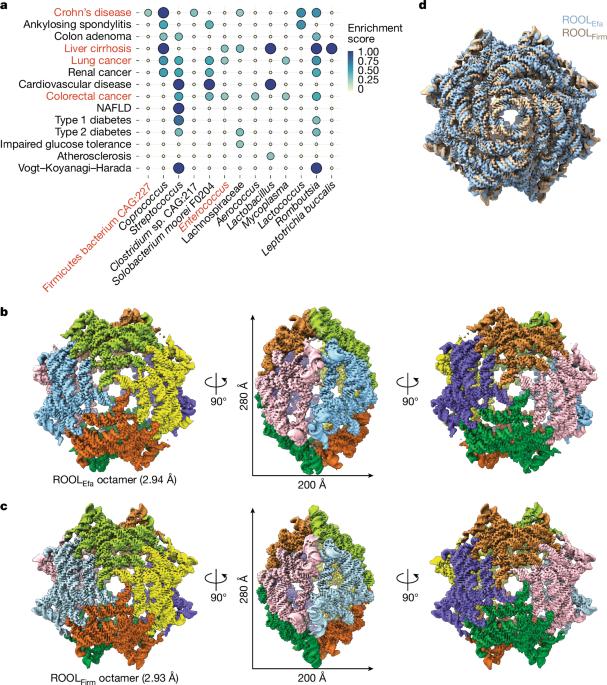天然RNA纳米笼的低温电镜结构
IF 48.5
1区 综合性期刊
Q1 MULTIDISCIPLINARY SCIENCES
引用次数: 0
摘要
长(200个核苷酸)的非编码rna (lncRNAs)在生命的各个方面发挥着重要作用。通过比较基因组学分析,已经在细菌和噬菌体中发现了20多种lncrna,但它们的生物学功能在很大程度上仍未被探索1-3。由于尺寸较大,大多数lncrna的结构决定因素也未被表征。在这里,我们报告了在细菌和噬菌体基因组中发现的由lncRNA ROOL(瘤胃起源,华丽,大)形成的两个天然RNA纳米笼的结构。~2.9 Å冷冻电镜(cryo-EM)结构显示,ROOL rna形成直径为28 nm、轴长为20 nm的八微米纳米笼,其中空内部具有无序区域。该八聚体通过许多三级和四级相互作用来稳定,包括我们建议命名为“A-minor订书钉”的三链A-minor。分离的ROOL单体在~3.2-Å分辨率下的结构表明,纳米笼的组装涉及链交换机制,导致了四元亲和环。最后,我们发现ROOL RNA与RNA适体、tRNA或microRNA融合后保留了其结构,形成了一个具有放射状显示货物的纳米笼。因此,我们的发现可能使新型RNA纳米笼的工程作为研究和治疗应用的运载工具。本文章由计算机程序翻译,如有差异,请以英文原文为准。

Cryo-EM structure of a natural RNA nanocage
Long (>200 nucleotides) non-coding RNAs (lncRNAs) play important roles in diverse aspects of life. Over 20 classes of lncRNAs have been identified in bacteria and bacteriophages through comparative genomics analyses, but their biological functions remain largely unexplored1–3. Owing to the large sizes, the structural determinants of most lncRNAs also remain uncharacterized. Here, we report the structures of two natural RNA nanocages formed by the ROOL (rumen-originating, ornate, large) lncRNA found in bacterial and phage genomes. The cryo-electron microscopy (cryo-EM) structures at 2.9-Å resolution reveal that ROOL RNAs form an octameric nanocage with a diameter of 28 nm and an axial length of 20 nm, in which the hollow inside features poorly ordered regions. The octamer is stabilized by numerous tertiary and quaternary interactions, including triple-strand A-minors, for which we propose the term ‘A-minor staples’. The structure of an isolated ROOL monomer at 3.2-Å resolution indicates that nanocage assembly involves a strand-swapping mechanism resulting in quaternary kissing loops. Finally, we show that ROOL RNA fused to an RNA aptamer, transfer RNA or microRNA retains its structure, forming a nanocage with radially displayed cargoes. Our findings, therefore, may enable engineering of novel RNA nanocages as delivery vehicles for research and therapeutic applications. Three-dimensional structures of two natural RNA nanocages reveal unique quaternary structures without the contribution of proteins.
求助全文
通过发布文献求助,成功后即可免费获取论文全文。
去求助
来源期刊

Nature
综合性期刊-综合性期刊
CiteScore
90.00
自引率
1.20%
发文量
3652
审稿时长
3 months
期刊介绍:
Nature is a prestigious international journal that publishes peer-reviewed research in various scientific and technological fields. The selection of articles is based on criteria such as originality, importance, interdisciplinary relevance, timeliness, accessibility, elegance, and surprising conclusions. In addition to showcasing significant scientific advances, Nature delivers rapid, authoritative, insightful news, and interpretation of current and upcoming trends impacting science, scientists, and the broader public. The journal serves a dual purpose: firstly, to promptly share noteworthy scientific advances and foster discussions among scientists, and secondly, to ensure the swift dissemination of scientific results globally, emphasizing their significance for knowledge, culture, and daily life.
 求助内容:
求助内容: 应助结果提醒方式:
应助结果提醒方式:


